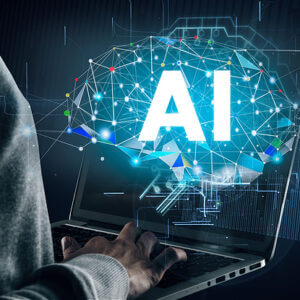There is every chance that the world’s industrial economies may be about to enjoy an incredible surge in productivity, something like the arrival of steam power in the 18th century.
The driver of this will be artificial intelligence. Gradually, it will seep into every aspect of our working and living, pushing up the amount produced by individual workers and leading to general economic growth.
The downside is that jobs will be eliminated, probably mostly, and historically for the first time, white-collar jobs. Put simply, office workers are going to find themselves seeking other work, maybe work that is much more physical, in everything from hospitality to healthcare to the trades.
I have canvassed many super-thinkers on AI, and they believe in unison that its impact will be seminal, game-changing, never to be switched back. Most are excited and see a better, healthier, more prosperous future, justifying the upheaval.
Omar Hatamleh, chief AI officer at the National Aeronautics and Space Administration, and author of two books on AI and a third in preparation, misses no opportunity to emphasize that thinking about AI needs to be exponential not linear. Sadly, linear thinking is what we human beings tend to do. To my mind, Hatamleh is in the vanguard of AI thinkers,
The United States is likely to be the major beneficiary of the early waves of AI adoption and its productivity surge if we don’t try to impede the technology’s evolution with premature regulation or controls.
Economies which are sclerotic, as is much of Europe, can look to AI to get them back into growth, especially the former big drivers of growth in Europe like Germany, France and Britain, all of which are scratching their heads as to how to boost their productivity, and, hence, their prosperity.
The danger in Europe is that they will try to regulate AI prematurely and that their trades unions will resist reform of their job markets. That would leave China and the United States to duke it out for dominance of AI technology and to benefit from its boost to efficiency and productivity, and, for example, to medical research, leading to breakthroughs in longevity.
Some of the early fear of Frankenstein science has abated as early AI is being seamlessly introduced in everything from weather forecasting to wildfire control and customer relations.
Salesforce, a leading software company that has traditionally focused on customer relations management, explains its role as connecting the dots by “layering in” AI. A visit to its website is enlightening. Salesforce has available or is developing “agents,” which are systems that operate on behalf of its customers.
If you want to know how your industry is likely to be affected, take a look at how much data it generates. If it generates scads of data — weather forecasting, electric utilities, healthcare, retailing and airlines — AI is either already making inroads or brace for its arrival.
PFor society, the big challenge of AI isn’t going to be just the reshuffling of the workforce, but what is truth? This is not a casual question, and it should be at the forefront of wondering how to develop ways of identifying the origin of AI-generated information — data, pictures and sounds.
One way is watermarking, and it deserves all the support it can get from those who are leading the AI revolution –the big tech giants and the small startups that feed into their technology. It begs for study in the government’s many centers of research, including the Defense Advanced Research Projects Agency and the great national laboratories.
Extraordinarily, as the election bears down on us, there is almost no recognition in the political parties, and the political class as a whole, that we are on the threshold of a revolution. AI is a disruptive technology that holds promise for fabulous medicine, great science and huge productivity gains.
A new epoch is at hand, and it has nothing to do with the political issues of the day.
Please Note: I will be hosting a virtual press briefing, which I have organized for the United States Energy Association, on the impact of AI in the electric utility industry on Wednesday, Oct. 2, at 11 a.m. EDT. It is open to the press and the public.
Here is the registration link:
https://us02web.zoom.us/webinar/register/WN_BbE_VO1bRo2PuiVl6g8IzQ#/registration

 Follow
Follow
Leave a Reply